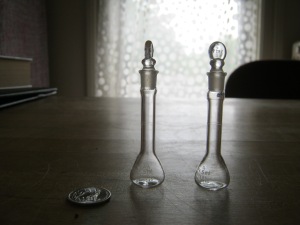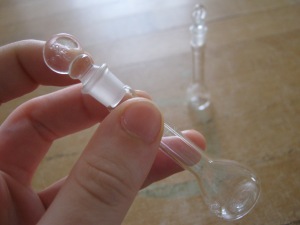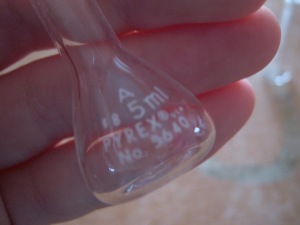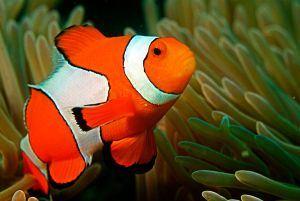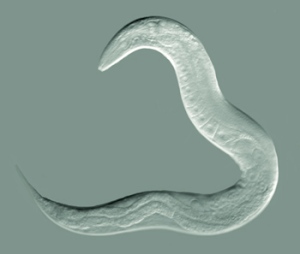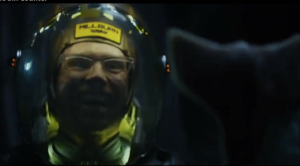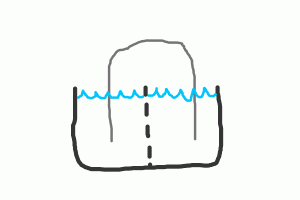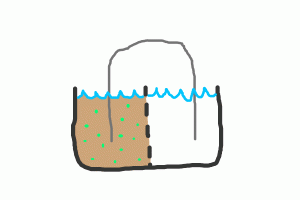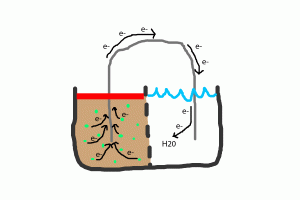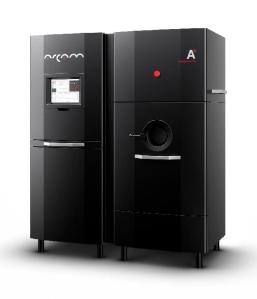Thanks to the positive response my last post got, I’ve put the source code for The Layers of English up on GitHub. You can find it here:
Category Archives: Cool Science
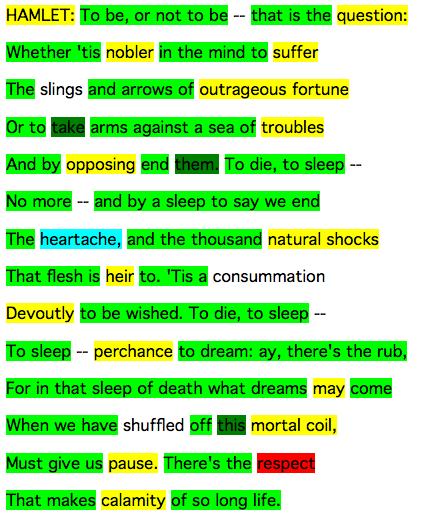
The Layers of English – Anglo-Saxon, French, Latin
The English language is a wonderful mess. After centuries where England got invaded by Romans*, Angles, Saxons, Vikings, and Normans, and then the nineteenth century where the English turned around and colonized one quarter of Earth’s landmass, the language has words from all over the world. English speakers seem to love picking up everybody else’s words whenever we come into contact with them.
English words come from three main sources. The oldest are the Germanic words from the Angles, Saxons, and the Vikings. The words that make up the nuts and bolts of the language like “the,” “of,” “and,” and “with” are Germanic. In 1066 Normans invaded and brought Old French with them, which evolved into words like “cuisine,” “gallant,” and “herald.” Meanwhile Latin and Greek were the languages of educated people throughout the Middle Ages and their words migrated into English in scientific and technical contexts. Words like these include “phosphorylation” and “poikilotherm.” This migration is still happening today as scientists are in the habit of stringing Greek and Latin roots together to name new ideas.
You, as a writer, can exploit the layers of English to control how your work sounds. You can dial up the register, towards Latin and Greek, to sound cool and cerebral. Or you can dial it back to the German end to sound gutsy and raw.
I wrote a computer program that lets you visualize how this works. It color codes text based on word origins.
All the texts I ran through the program are more than half Anglo-Saxon and Germanic. These words make up the core of the English language. Note how Dr. Seuss and Shakespeare run to the Germanic end, the political and scientific texts are more French, and the scientific paper is a whopping eight percent Greek and Latin words.
You can use this tool to see where a writer makes a shift in register as well.
I’d eventually like to make this program a Web app. In the meantime, send me a text you like and I’ll analyze it.
* A Redditor pointed out to me that the people living in the area at the time the Romans invaded spoke Celtic languages, which aren’t closely related to English, so the Roman invasion wouldn’t have had that much of an effect on English evolution.
TECHNICAL STUFF
This code is written in Python. I’m new to programming, so I learned a lot while writing it – about dictionaries, variable scope, JSON, and regex.
I used word lists on Wikipedia to make an etymology dictionary. Then I wrote a script that reads in the text, looks it up in the dictionary, then adds HTML tags based on the word’s etymology. It outputs an HTML file.
I handled Greek words a bit differently, since there is no definitive list of English words with Greek roots. I made a list of Greek roots (again from Wikipedia). If no other etymology can be found, the script searches for Greek roots within a word. As you can see, this leads to some false positives. Furberg, a Norwegian last name, got marked Greek because it has the letters “erg” inside it.
I checked the program on the Ten Hundred Most Used Words that were inspired by Randall Munroe and reprinted by Theo Sanderson. I took the words that the program had missed and manually looked them up on the Online Etymology Dictionary, then added them to my dictionary’s vocabulary. I wanted even more vocabulary, so I ran the program again on the first five thousand of this list of the twenty thousand most common words online. Then I went back and manually added more words.
I added Arabic etymology because “coffee” showed up in the Ten Hundred Most Used Words list, and I like coffee.
I’d be happy to share my code and I would love a code critique.
Text sources:
The Gettysburg Address
Hamlet’s Soliloquy
Hop on Pop
The United Nations Declaration of Human Rights
A Structure for Deoxyribose Nucleic Acid
Scientists Looking at Liquid
This all started because I saw an ad on the back of a magazine. The ad was for a DNA assembling machine and featured a woman looking at a tiny vial of amber liquid, which seemed oddly specific. Where could a biotech company get such a picture? Vu was there and he said it was probably a stock photo. Pictures of scientists looking at liquid are everywhere.
So I checked.
Pictures of scientists looking at liquid are everywhere. These are some of my favorites from a Google image search for “scientist:”
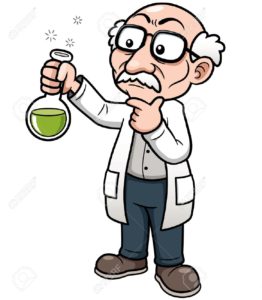

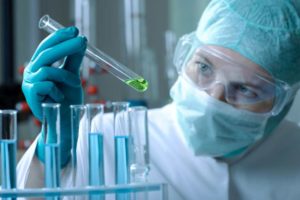

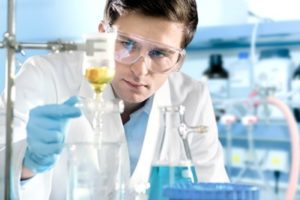
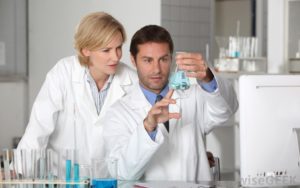
The only thing we seem to like half as much as looking at liquid is looking at microscopes. But that’s a distant second. Looking at liquid is definitely the favorite. Especially if it’s green.
Do you guys have any favorite pictures of scientists looking at liquid? Could you please share them with me?
This is Neat: The Uncanny Valley
What is the uncanny valley? Suppose you win a sweepstakes and the prize is that you get to spend a day hanging out with a robot. You get to pick one of the following companions:

.
An industrial robot.
.
.
.
.
.
.

.
Aww!
.
.
.
.
.
.

.
OH GOD WE HAVE TO TAKE OFF AND NUKE IT FROM ORBIT
.
.
.
.
.
.

.
A mannequin that’s kind of creepy.
.
.
.
.
.
.

.
Are you sure that’s not just a photo of a woman?
.
.
.
.
.
.
The different reactions you just had to the different faces demonstrate the uncanny valley. We’re fine with completely human or completely nonhuman faces, but many people find faces that are somewhere in between creepy.
Though there’s some evidence that the uncanny valley is a real psychological phenomenon, so far it has been mostly speculative. In a recent paper published in the journal Cognition, a pair of scientists sought to reproduce the uncanny valley experimentally.
Theoretically, this is how we think people will react to faces depending on how human or nonhuman they look:
 The researches collected eighty snapshots of real-life robots that people have actually built. (The five photos above are from their collection.) They asked research participants to rate each face for “mechanicalness” and “humanness” on a scale of 0 to 100. That way they could quantify how far to the left or right each robot belonged on the uncanny valley chart.
The researches collected eighty snapshots of real-life robots that people have actually built. (The five photos above are from their collection.) They asked research participants to rate each face for “mechanicalness” and “humanness” on a scale of 0 to 100. That way they could quantify how far to the left or right each robot belonged on the uncanny valley chart.
Then they recruited a fresh set of participants who wouldn’t be biased by having seen the faces before and asked the new set of people to rate each face on “friendliness.” This is what the researchers got:
 This figure looks a lot like the uncanny valley chart we expected. There’s a peak in likability with the cute robots that look a little human, and another peak with the robots that look like regular humans. But note that the 100% industrial robots didn’t do too shabby.
This figure looks a lot like the uncanny valley chart we expected. There’s a peak in likability with the cute robots that look a little human, and another peak with the robots that look like regular humans. But note that the 100% industrial robots didn’t do too shabby.
How well people like or dislike a robot’s face is one thing, but does that affect what people actually do? This is a question engineers care about. If they want to build a robot that’s meant to socialize with people, they’d rather not have their human clients secretly trying to kill it. The researchers involved in this paper recruited another batch of participants to address this question.
They gave each participant some imaginary money. Participants got to decide how much money to give to one of the robots in the pictures. Here’s the important part: the researchers told the participants that the robot would decide how much money to give back. Participants who did especially well at maximizing their imaginary money in the game would win real money as a prize. So the participants had to make decisions about how much they trusted each robot with real money at stake.
These are the results:
 The researchers found an uncanny-valley-like pattern again.
The researchers found an uncanny-valley-like pattern again.
Based on this research, we have evidence that the uncanny valley really exists and that people make decisions with important consequences based on it. So if you’re a designer and you want to avoid get me a cross and some holy water moments, you should keep your robot out of the valley.
The article is open access, so you can read the whole thing here: http://www.sciencedirect.com/science/article/pii/S0010027715300640
Urtica ferox
Itty Bitty Erlenmeyer Flasks!
One of the labs at the university where I work was holding a giveaway to get rid of their old junk. I checked it out, and among the offerings were the tiniest Erlenmeyer flasks:
Each flask holds 5mL of fluid, as you can see in the next picture:
I have no earthly idea what they could be useful for, but there they were.
A Trip to the Zoo
So the other day I came across this little gem: God Made Dad & Mom. In a nutshell, the message of this book is that Heather must have exactly one mommy and one daddy and that’s that. You can see what readers’ reactions were on Amazon.
I haven’t been able to get my hands on this book, and I’m not particularly interested in spending any money on getting it, so I’m going to have to use my imagination here. The book’s description says that the story goes like this:
In school, young Michael learns that God made men to be fathers and women to be mothers. After school, his father takes him to the zoo, where he learns that animal families consist of a male, a female, and their offspring.
For all you people on the internet who are not lucky enough to possess a copy of God Made Dad & Mom, here is my proposal for the zoo sequence:
A Trip to the Zoo
That afternoon, Michael goes to the zoo to learn about animal families. First he goes to the lion enclosure.
Lions live in groups called prides. A lion pride is made up of one or two males, five or six females, and their cubs. Each male will mate with all of the females.
Here’s the hyenas!
The female spotted hyena has a pseudopenis, which makes her look like a male. She will give birth through this pseudopenis.
Let’s move on to the bonobo exhibit.
…
It looks like they’re kinda busy right now. We should come back later.
These are the whiptail lizards. They live in the deserts in North America.
In some species, every whiptail lizard is a female. When they lay eggs, the baby lizards are exact copies of their mother.
Let’s move on to the aquatic exhibits.
Corals are animals, even though they don’t look like the animals you may be used to. Corals never mate. At a certain time of the year, corals release egg cells and sperm cells into the water. The eggs and sperm join to form a new coral, which drifts along in the water until it can find a new home.
If you look closely, you might be able to see clownfish hiding inside the sea anenomes.
Clownfish live in groups called schools. The leader of the school is a female clownfish. When that female dies, one of the males turns into a female and becomes the new leader.
You don’t even have to go to the zoo to find animals with interesting families. If you take some dirt from your backyard and look at it under a microscope, you’ll find a kind of worm called C. elegans.
Most C. elegans worms are hermaphrodites, which means that they are both male and female at the same time. They can self-fertilize, so one worm is both daddy and mommy to its eggs!
If Prometheus had been an actual scientific expedition
I just went and saw the movie Prometheus the other day, and all I have to say is, ouch. And not just because Noomi Rapace gives herself a C-section, either. The problem is that now that I work in a science field, all science fiction movies have been ruined for me.
The science of Prometheus isn’t even all that bad. It takes some stabs at plausibility, like when the exploration team can’t breathe the atmosphere because it contains 3% carbon dioxide. That’s actually pretty accurate. Suddenly breathing 3% carbon dioxide, when it’s not what you’re used to, would be bad for you.
The bigger problem is the scientists. They make so many poor professional decisions in this movie, that if this had been a real research expedition, they would all have lost their jobs and been so thoroughly discredited they could never find another academic job, anywhere, ever. Sure, the idea was to make the movie more exciting, but I think it gives people the wrong idea about what the job is actually like. So I thought I would write this post about how Prometheus would have gone if the expedition had been run by actual scientists.
This is neat: microbial fuel cells
Hello and welcome to the second installment of the cool stuff I saw at the National Association of Science Writers conference.
Dr. Bruce Logan of Penn State University is seeking to address two global problems at once. One of these problems should be pretty familiar: we need new and better sources of energy. The other problem is one that you probably don’t think about much. The treatment of wastewater has a high energy cost. In the United States, 1.5% of all our energy consumption goes to wastewater treatment alone.
Dr. Logan hopes to turn wastewater around into a potential energy source. Wastewater is literally full of crap, but the cellulose and other organic molecules in it contain energy in their chemical bonds that bacteria can digest. If we can get bacteria to digest organic matter in the right environment, we can harvest electricity from the chemical bonds at the same time that the water is being purified.
The self-contained units that Dr. Logan and his team build to house the bacteria are microbial fuel cells.
The basics of the microbial fuel cell
The microbial fuel cell contains two chambers that are each filled with water. The membrane that separates the two chambers only allows ions to pass through. This prevents charge from building up when electrical current is passing through the system. A metal wire runs from one chamber into the other.
Step one: Collect a sample of bacteria from a wastewater treatment plant. Put the bacteria, along with some “fuel,” into one chamber.
Step two: Seal the chamber with the bacteria off from the air. When bacteria digest organic molecules, they strip electrons off of them. Eventually, these electrons have to go somewhere. Oxygen will take the electrons if oxygen is around, but if there is no oxygen in the chamber, the bacteria are forced to dump the electrons into the wire.
Step three: At the other end of the wire, the electrons combine with oxygen and protons to form water. Now electrons are continuously passing through the wire. Current! You can hook an electric-powered device up to the wire and it will run.
Benchtop versions of these microbial fuel cells already work. Click here to watch a video of a microbial fuel cell running a fan. And here, you can learn more about the Logan lab’s work.
This is neat: 3D printing makes replacement bones
At the National Association of Science Writers conference last October, I got to listen to a number of scientists give talks about the coolest things that are going on in their fields today. One of these cool, cool scientists is Dr. Ola Harrysson, an associate professor of industrial and systems engineering at North Carolina State University. He’s teamed up with Dr. Denis Marcellin-Little of the veterinary school at NC State to engineer better bone prostheses for pets.
One of the reasons owners come to Harrysson and Marcellin-Little is when a beloved pet gets osteosarcoma, a cancer of the bone. Veterinarians can receive the diseased bone and save the pet’s life, but the limb with the missing bone is now useless.
For example, this is Cyrano, a cat who lost part of his knee to osteosarcoma. He received a knee replacement from the team in 2012.
First, the team takes a CT scan of the affected limb. Using computer aided design, they create a 3D model of what a bone prosthetic to fill in the gap would look like.
In the old days, the metal alloy used to make the prosthetic would then have to be cast or wrought into the precise shape needed for the final product. Metal casting and working are extremely expensive when the final product has a complex shape, such as a bone prosthetic, and only one of the product will ever be needed.
That’s where Harrysson’s engineering expertise comes into play. Harrysson collaborates with the company Arcam AB, which developed a rapid-prototyping machine (commonly known as 3D printing) that can work with molten metal. First, a layer of powdered metal alloy is spread out on a surface. The rapid-prototyping machine uses the data from the computer aided design program to selectively fuse regions of the powdered metal with an electron beam. Then another layer of powdered metal is spread on top of the surface and the process repeats.
The machine builds up layer after layer of fused-together metal until the bone prosthetic is complete.
Here’s what the machine looks like:
.
Here’s a model of Cyrano’s new knee. That’s Dr. Marcellin-Little in the foreground.
The prosthetic is then implanted into the pet. Because the edges of the prosthetic are porous, bone cells grow into the gaps and the prosthetic ultimately fuses with the animal’s own bones.
Dr. Harrysson and Dr. Marcellin-Little have given bone prosthetics to eight animals so far. Now that he has received the knee replacement, Cyrano’s prognosis is excellent.




